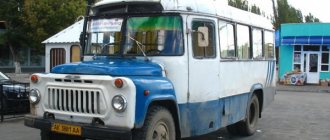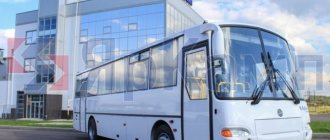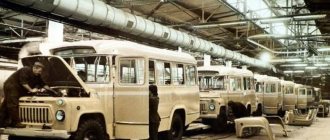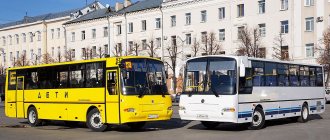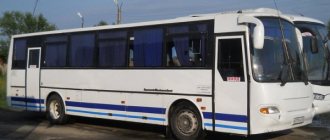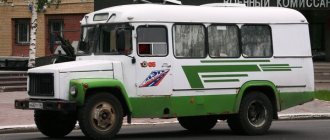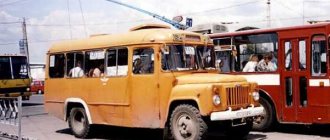City bus KAVZ-4238. Photo YarCamp
In 2006, production of various modifications of the PAZ-4238 was established at the Kurgan Bus Plant under the KAVZ-4238 “Aurora” brand. In 2010, a school bus based on the KAvZ-4238 Aurora was created and certified. The Kurgan Bus Plant became the first in Russia to develop a school bus based on GOST R 51160-98 “Buses for transporting children. Technical requirements". In 2012, the Kurgan Bus Plant developed the KAVZ-4238, which runs on compressed natural gas and is equipped with a gas engine that meets the Euro-5 environmental standard. In 2013, a prototype was manufactured and certified.
Detailed description, device
KAVZ-4238 is an extended modification of the KAVZ-4235 bus, designed to operate on suburban and intercity routes up to 500 km long.
A comfortable interior, an optimal number of seats, spacious luggage compartments (!not available for all modifications), and an economical engine make the KAVZ-4238 bus attractive for both passengers and commercial carriers.
In 2013, a gas modification of the bus was developed.
Tropical version: powerful air conditioning, enlarged side window vents, tinted windows, tires suitable for use in tropical climates, vandal-proof seats.
School version: in accordance with GOST R 51160-98 “Buses for transporting children. Technical requirements".
KAVZ-4238 school bus. Photo YarCamp
Modifications:
- KAvZ-4238-00 – long-distance, basic model
- KAvZ-4238-01 – suburban
- KAvZ-4238-02 – long-distance
- KAvZ-4238-04 – urban
- KAvZ-4238-05 – school
- KAvZ-4238-21 – suburban gas
- KAvZ-4238-41 – suburban
- KAvZ-4238-42 – long-distance
- KAvZ-4238-45 – school
- KAvZ-4238-51 – suburban
- KAvZ-4238-52 – intercity gas
- KAvZ-4238-62 – school
- KAvZ-4238-71 – suburban gas
- KAvZ-4238-72 – intercity gas
- KAvZ-4238-75 – school gas
- KAvZ-4238-81 – suburban gas
- KAvZ-4238-82 – intercity gas
- KAvZ-4238-85 – school
Modifications operating on gas are often labeled CNG.
Reference . Diesel and gas modifications have differences in some quantitative parameters and engine characteristics. At the same time, buses for different purposes have differences in interior design.
KAvZ-39766, all-terrain bus
An all-wheel drive bus is a rare type of equipment, but sometimes such vehicles are simply irreplaceable.
One of the few representatives of the family of all-terrain buses was KAvZ-39766. The hooded bus KAVZ-39766, which began to be produced in Kurgan in 2003, was an “off-road” version of the standard model KAVZ-3976.
Like other bonnets of the plant, KavZ-39766 was based on the chassis of a GAZ truck, but not an ordinary “lawn”, but a GAZ-3308 “Sadko” all-terrain vehicle. The chassis of the bus was the same as that of the truck - all-wheel drive with a plug-in front end, and a reduction gear.
Such KAVZs mainly worked as service buses in areas with bad roads, shift work, and there was also an option for transporting schoolchildren. Inside the car there are from 12 to 20 seats, depending on the version.
KAvZ-39766 was equipped with a gasoline carburetor eight-cylinder engine ZMZ-513.10 with a volume of 4.25 liters (125 hp) and a four-speed gearbox or a four-cylinder diesel engine MMZ-D-245.7 with a volume of 4.75 liters (122 hp) in combination with five-speed gearbox.
The price of a gasoline bus in 2003 was 760 thousand rubles, the diesel version cost from 835 thousand rubles.
Production of the KAvZ-39766 model ended in 2007, at the same time the plant stopped producing all other hooded buses.
Thank you for reading to the end!
Even more interesting reviews about cars are in our Yandex-Zen channel . Also check out our community on VKontakte .
Source
Basic information, characteristics
Interior of the intercity bus KAvZ-4238 Aurora. Photo Skat-Auto
Manufacturer/manufacturer where the equipment is produced/manufactured. "KAVZ" (formerly the Kurgan Bus Plant named after the 60th anniversary of the USSR (KAvZ)) is located in the city of Kurgan. LLC "KAvZ" is a subsidiary of OJSC "GAZ" (100% share in the authorized capital). The functions of the sole executive body of this company are performed by the management organization - LLC "UK Group GAZ".
Purpose. Suburban, intercity, city, school.
Class. Average.
Body type. Carrier, carriage layout.
Body resource. 8 years.
Basic characteristics
Body dimensions, mm. Length/Width/Height – 10030 / 2500 /3060 (3110 with air conditioning).
Ceiling height in the cabin, mm. 1980.
Number and dimensions of doors. 2/650.
Total number of seats, including landing seats. 40 (35+1), 44 (39+1).
The type of seats depends on the purpose of the bus. The intercity cabin is equipped with soft, adjustable seats, with armrests, on a podium, and with seat belts. City, suburban and school - plastic seats with soft inserts.
Kavz 4238-65 school
KAVZ 4238-65 bus for transporting schoolchildren to educational institutions and to excursion sites. It is equipped with a special device that does not allow driving with the doors open, a speed limiter that does not allow the speed to exceed 60 km/h, and emergency communication buttons with the driver are located in the cabin. It has 34 seats, including 2 for accompanying persons. KAVZ 4238-65 is equipped with soft and comfortable seats with seat belts, racks for backpacks and a retractable step on each door for convenient descent and ascent of the smallest passengers. The bus is painted yellow, and the words “Children” are written on the body. KAVZ 4238-65 fully complies with the requirements for transporting children.
| Passenger capacity | 34 + 1 |
| Number of passenger doors | 2 (width 650 mm) |
| Overall dimensions, mm) | 10000x2500x2970 |
| Engine | YaMZ 53403; 209 hp; diesel; Euro 5 |
from 01/01/2022 GAZ Group plans to increase the price of equipment by up to 7% for the entire line of buses
Specifications
Intercity bus KAvZ-4238 Aurora. Photo Author
Fuel type. Diesel/gas
Fuel tank capacity. 170 / 615 or 739 (5 cylinders).
Curb and technically permissible weight, kg. 8320…8685 or 8435…8800/12600 / 8814…8929 or 9350…9465/12600.
Load on front/rear axle based on technically permissible weight, kg. 4290/8310.
Minimum turning radius, m. 11.
Front approach angle/rear departure angle, degrees. It varies for different modifications, it is recommended to check when purchasing.
Steering gear. ShVGU-430 or ZF-8095 integral type.
Brake system. Working: pneumatic, dual-circuit, with division into circuits along the axes, drum brakes on all wheels, ABS. Parking: rear wheel brakes. The drive is mechanical from spring energy accumulators with pneumatic control. Spare: performs one of the circuits of the service brake system. Auxiliary: engine brake.
Characteristics of KAVZ-4238 intercity
Main characteristics
| Bus model | KAVZ-4238 | |
| Bus class | Average | |
| Purpose | Intercity | |
| Basic parameters of modifications | ||
| Wheel formula | 4x2 | |
| Body type | Carrier, carriage layout | |
| Overall dimensions, mm | Length | 10000 |
| Width | 2500 | |
| Height | 2970 or 3110 | |
| Base, mm | 4900 | |
| Number / width of doors, mm | Two pneumatic doors (650 mm), clamp-type doors | |
| Brake system | Working | pneumatic double-circuit drive with division into circuits along the axes, with ABS; front wheel brakes - disc or drum, rear - drum |
| Parking | drive from spring energy accumulators to the brake mechanisms of the rear wheels | |
| Spare | each circuit of the service brake system | |
| Ventilation | Natural | |
| Fuel tank capacity, l | 170 | |
| Bridge | KAAZ | |
| Weight, kg | Curb | 8320. 9030 |
| Full | 12600 | |
| Number of places | General | 40 |
| Boarding | 35 | |
| Maximum speed, km/h | 100 | |
Power unit (Diesel)
ZF 6S 1010 BO, with manual control, forward - 6, reverse - 1
| Engine (type) | YaMZ 53403 | |
| Location | Rear, longitudinal | |
| Number and arrangement of cylinders | 4R | |
| Environmental safety standards | Euro-5 | |
| Engine displacement, cm 3 | 4433 | |
| Compression ratio | 17,5 | |
| Maximum power, kW, (min -1) | 154 at 2300+-25 | |
| Maximum torque | 780 (1200. 1600) | |
| Transmission | Mechanical | |
| Clutch | dry single-disc | |
| Gearbox (brand, type) | ||
| Suspension | Front | dependent, on longitudinal semi-elliptical springs, with two air springs, with hydraulic telescopic shock absorbers and anti-roll bar or independent, lever, with two air springs and two floor level regulators, with two hydraulic telescopic shock absorbers |
| Rear | dependent, on longitudinal semi-elliptical springs, with two air springs, with hydraulic telescopic shock absorbers and a stabilizer bar or dependent lever, with four air springs and two floor level regulators, with four hydraulic telescopic shock absorbers and a stabilizer bar | |
| Steering (make, type) | steering mechanism - “screw-ball nut-rack-sector”, with power steering | |
Other characteristics
| Body painting | Base color is white. Upon request when choosing from a color catalog | |
| Doors | Two doors are pneumatic, clamp type, electrically controlled, equipped with emergency buttons for passengers to exit. | |
| Window | Single glass, installed, glued | |
| Passenger seats | Separate, soft, high back, fabric upholstery, adjustable, folding armrests. | |
| Driver's seat | On air suspension | |
| Seat belts | Installed at the driver's and passengers' seats | |
| Heating system | Ventilation and heating systems. Autonomous pre-heater, liquid heaters in the cabin, individual heating for the driver | |
| Rear view mirrors | Installed in streamlined holders, adjustable from the driver's seat, heated. | |
| Lighting | Combined headlights, horizontal rear lights, front fog lights. | |
| Interior | Partition behind the driver, driver's sun shade, hammers for emergency window breaking, emergency opening of interior doors possible. The interior upholstery is fabric. Luggage racks are installed above the passengers. | |
| Equipment | Jack, spare tire, tool kit. | |
additional characteristics
Ventilation. Natural, through the roof hatches and side window vents. The windshield is blown from the front heater.
Heating system. Combined, from the engine cooling system and liquid heater. 3 heaters are located in the cabin, the driver’s workplace is heated by a front heater with two air intake modes.
Luggage compartment volume, cubic meters Luggage compartments in modifications differ in design and volume. Some modifications have pass-through luggage compartments.
Luggage compartment location. In the middle lower part of the body.
KAVZ 3976 Family Motorhome ⇐ Other models
Post by Andrey_irk » 21 Dec 2022, 08:59
Post by POL » 21 Dec 2022, 11:07
Post by ABR-auto » 22 Dec 2022, 07:48
Post by Andrey_irk » 16 Jan 2022, 09:19
Friends, I’ll write what’s been done about the bus: On the one hand, it’s good when the bus is at the enterprise, it seems like they don’t save money, they carry out maintenance, but the owner of the car doesn’t exist, and this leads to consequences. 1 Consequence of traveling on water, the radiator was completely rotten, I took it in for repairs and they said it was beyond repair. I bought it for 1000 rubles. radiator with two fans from a Subaru Impreza mechanic. The area is slightly larger and the thickness is slightly smaller. Let's see how the engine temperature will be. I immediately wanted to convert the constantly rotating fan to electric. I want to install two temperature sensors (8-) one turns on early and the other turns on later, so that if suddenly there is a reserve on the fan on the road. I turned off the second stove for now (series 020 - northern version) otherwise you won’t have enough antifreeze, as soon as I check the whole system, maybe I’ll power up the second stove. 2 The consequence is a shitty 80 petrol and a dirty carburetor. I cut off the resin stalactites with a knife. Later I bought a repair kit and will replace it. 3 Replaced all the optics, headlights, turn signals.
What else. As a result, the bus will be category M1 (for transporting people), but you can drive it with a category “C” license. Today we agreed with the person on the documents for re-registration into a turnkey “Auto-home”, all that remains is to agree on the list of changes, we will meet. The price tag (33,000 rubles) is normal, I think.
I’m slowly thinking about what to do with the gearbox, most likely it will be a Japanese manual transmission, in the future, if I don’t like it, I’ll install an automatic transmission from a truck, there are those too, and even some sell them cheaper than manual transmissions. The interior found 3 rows of seats from HONDA Elysion, which are very comfortable while driving, but you need to think about how to transform it into a bed.
I wrote to Dmitry from the Moscow region, he travels in a motorhome 6 out of 12 months of the year, we had a very close correspondence, and gave a lot of useful advice. I’ll try to sort everything out in some kind of message.
That's all for now, let's do it slowly. I work out in the evenings and on weekends when it’s warm. Good luck to all!!
Source
Engine/powertrain characteristics
| Options | CUMMINS 6 ISBE4 210V | CUMMINS 6 BGE5 230 (CNG) |
| Type | Diesel engine | Gas engine |
| Number and arrangement of cylinders | 6R, vertical | 6R, vertical |
| Environmental safety standards | Euro 5 | Euro 5 |
| Working volume, l | 6,7 | 5,9 |
| Engine power, kW (hp)/min | 145 at 2300 min-1 | 168.8 at 2,800 min-1 |
| Max. torque, Nm/min | 750 at 1100…1800 min-1 | 678.3 at 1,800 min-1 |
| Engine location | Rear, longitudinal | Rear, longitudinal |
| checkpoint | Manual transmission: ZF 6 S 1010 BO, 6 speed. or Eaton, FSO-5206 | Manual transmission: ZF 6 S 1010 BO, 6 speed. or Eaton, FSO-5206 |
| Maximum speed, km/h | 100 | 100 |
| Bus warranty | 2 years or 100 thousand km | 2 years or 100 thousand km |
Additional options
Reliability indicators:
- Service interval - 12 thousand km
- Ease of maintenance
- Possibility of installing automatic transmission
Performance indicators:
- Favorable cost of ownership
- Optimal passenger capacity
- Reduced operating costs due to low gas fuel costs
- High level of comfort for driver and passengers
- Affordable price
Comfort options:
- Audio/video system
- Various passenger seat options
- Electronic route indicators
- Metallic body paint
- Insulated clear glass unit.
- Tinted double-glazed window (only for the Insulated modification).
- Exterior (new front mask with Hella lighting technology).
- DVD, CD player with 2 LCD monitors 15″ + 6 speakers + antenna.
- DVD, CD player with one 19″ LCD monitor + 6 speakers + antenna.
- VGGU.
- NGGU loudspeaking device.
- CD radio + 4 speakers + antenna.
- Roof fan (blowing the driver's workplace or passenger compartment).
- Electronic route indicator Iskra 4235/4238 (three displays).
- Tires MICHELIN or MATADOR 275/70 R22.5.
- Air conditioning with individual airflow.
- Luggage racks.
- Passenger seats with a device for moving to the center, with a net and a table.
- Curtains on the salon windows.
- Plastic upholstery.
- Interior upholstery is caprovelor.
- Carpeting in the center aisle + mats on the front and rear landings + on the front steps.
- Carpeting in the luggage compartment.
- Air autonomous heater.
- Double glazing of salon windows (tinted double glazing).
- Double glazing of salon windows (clear glass).
- Single glazing is tinted, except for the windshield, driver's window and front door glass.
- Thermal insulation of heating and cooling system pipelines.
- Heating the fuel tank intake.
- Non-adjustable seats with 3-point seat belts.
- Adjustable seats with 3-point seat belts.
- Satellite navigation equipment.
- Air autonomous heater for the driver's cabin.
- Gas cylinders capacity 739 l.
- Reversing sound signal.
Security options:
- Digital tachograph
- Video surveillance system
- Fire extinguishing system
- Fog lights
A little about the layout.
I’ll dwell a little on the layout of the living and working space of the motorhome. Here, by definition, there cannot be a single correct solution, since a lot depends on the subjective perception of such things as comfort, convenience, necessity, and so on. And the second important point is that any decision when planning a motorhome is essentially a compromise, starting from cross-country ability and ending with making a larger shower room or kitchen area. Therefore, I will give some explanations on certain points related to planning and why exactly this way and not otherwise.
First, a short lyrical digression. Most of the decisions were made on the basis of the invaluable experience that was gained in previous travels and which cannot be obtained by reading other people's opinions on the Internet. Some trips were very, very long (the longest was three months on TLC80 without using hotels or tents). Now to the point. Before directly thinking through the interior layout, we tried to formulate as clearly as possible the requirements that our motorhome must meet, identify those things that definitely should be present and, accordingly, which definitely should not be in the motorhome, and set priorities. It is no coincidence that I dwell on this point in such detail, since for many who are just starting to think about any issue, the biggest problem is that they do not have a clear idea of what exactly they want to get in the end. As a result, disappointment with the result obtained. The following was put at the forefront of the entire concept: comfort for us is important only in terms of AVAILABILITY as a fact of vital living conditions, to which we include complete healthy sleep, uncompromising comfort (in terms of maintaining health and the ability to maintain working capacity for a long time) of the driver and navigator(! ) seats, the presence of a shower/toilet, the presence of a backup heating option in case of failure of the main system, the presence of an emergency exit for both the driver and the navigator. Well, now, in fact, I will try to highlight the issues that for many are the most controversial when planning a motorhome. 1. Why didn’t we leave the main door for the navigator, but made it central, losing some space in the cabin? The only reason why the navigator's door was left in place at all is stated above. It is considered exclusively as an emergency option for leaving the car, especially for ice crossings (no matter what anyone says, but I have more than enough examples of people who neglected the rule of driving with an open door on ice, examples of which are deplorable, unfortunately). Having experience driving Korean buses with only a middle door plus a driver's door, I am sure that exiting through the passenger compartment will not cause discomfort. 2. The size of the bathroom is 70x110. Of course, a larger shower room would be more comfortable, but then somewhere the same space will have to be taken away, the question is - where? It was this question that forced us to revise the layout many times, rearranging everything that was possible in the most unimaginable way. As a result, the conclusion was that without sacrificing something vital for us, it simply would not be possible to achieve a better result. And based on the concept described above, a shower only requires its presence, but not the ability to use it comfortably. That is, for us, for example, it is much more important to sleep on a stationary bed that does not require constant folding/unfolding, on a normal orthopedic mattress, and not just a paralon covered with leatherette, than to be able to move freely around the shower room. Again a compromise. 3. About the refrigerator. During global travel, only two people will be in the motorhome at all times. Up to four people only for local use, for example, outings for one or two days and up to six people for a short time, without planned overnight stays within the cabin. We see the need for a refrigerator only during long trips, but for two people we don’t need much, again from experience. When traveling on a Kruzak, by the way, we basically did not have a refrigerator, however, this did not affect the positive impressions of the trip as a whole). 4. About the central door. The second sore point of this car. Yes, we tried for a long time to leave the front door and, if you look at the original layout in the picture below, it was left as is. But! In any option, this inevitably led to the need to move/fold the navigator’s seat, or to make it quite compact and, therefore, not comfortable enough. And in addition to this, it excluded the possibility of a smooth transition for the driver to the bus interior.
